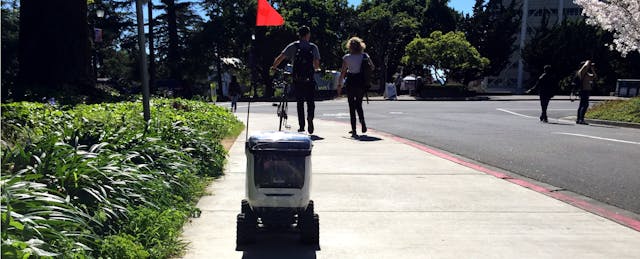Robots are taking over college campuses. Not as android professors or virtual students, but as automated food delivery devices.
The University of California at Berkeley and University of California, Los Angeles were two of the earliest colleges to welcome the food delivery robots, called the KiwiBot. Now the startup behind the roaming drone, Kiwi, has plans to expand to 15 more campuses including Harvard and MIT, the company said this week at ArticulAte, an event in San Francisco about food robotics.
Kiwibots just announced it's expanding to 15 campuses including Harvard, UC Davis, MIT, Stanford and universities in NY and Texas. They're currently only at UC Berkeley. pic.twitter.com/fnlGkSSXAp
— Leonardo Castañeda (@LeoMCastaneda) April 16, 2019
There are currently a handful of app-based food delivery services, from DoorDash to Uber Eats. But the KiwiBot, which looks like a two-foot-high cooler on wheels, has caught the attention of hungry college snackers and curious passersby alike. So this week I decided it was time to finally give one a try.
After finding a bench under a tree at UC Berkeley, I pulled out my phone to figure out how it all works. Ordering from KiwiBot is pretty simple: Download an app, choose what you want to eat, and select the exact delivery location using your GPS coordinates. Users can pay with a credit card or Venmo, a social payment app.
I ordered a carnitas burrito. As I waited for the food, the app notified me of the order status, and as the meal got closer, I could watch its journey through a live video feed on the robot.
It took a little while. Within about 30 minutes, I finally saw a small orange safety flag cruising my way. The wait could be due to the fact that the KiwiBot strolls along at a leisurely 1 mile per hour. It parked a couple feet away from me and the app notified me that my food had arrived. To get the food out—and to avoid possible snack theft—a user unlocks the KiwiBot’s door through a button on the app that appears once the food arrives. A latch slowly opened, I grabbed my burrito, and we both went our separate ways.

The service is admittedly convenient and straightforward. But perhaps not always easy on a budget: The burrito itself cost $12.50, and after delivery fees my total came to $17.46.
On top of the bill, the other cost you really can’t avoid is looking or feeling silly pulling a meal—no matter how tasty—out of a robotic ice chest on wheels.
Things are a bit more complicated for the delivery robot. For starters, there is the process of getting the food to the robots. It is not fully automated. After someone places an order, a human who rides around on a bike with a large basket must pick up the food from the vendor, put it inside the KiwiBot, and then drop off the robot within a mile of its delivery destination.
The KiwiBot then navigates busy sidewalks and intersections using a combination of cameras and lasers to map the surrounding environment.
The technology behind the robots may still need some fine-tuning. Last December, a KiwiBot caught fire outside of UC Berkeley’s student union. The company said that the malfunction was caused by a botched battery, and the robots were temporarily pulled off campus for investigation.
No human was hurt in the incident. But students did host a candlelight vigil for the fallen KiwiBot.
Kiwi isn’t the only company trying to bring food delivery bots to college campuses. There’s also Starship Technologies, which began shuttling a fleet of 25 food robots around George Mason University earlier this year. And in March the machines arrived at Northern Arizona University.
These devices are also giving universities a glimpse into students’ eating habits, and how they are changing with the delivery robots. The Washington Post reported that breakfast has become the most popular meal for students at George Mason University to order.
London-based Starship Technologies charges $1.99 per delivery. It first tested the delivery robots on corporate campuses, and last year began deploying them to deliver items ranging from lunch to office supplies at financial company Intuit’s offices in Mountain View, Calif., according to Business Insider.
The co-founders of Starship Technologies previously worked on robots that collected rock samples on Mars and the moon, so it’s no surprise that the food delivery version bears a small resemblance to space rovers.
Kiwi launched in 2017, specifically on college campuses. The company’s founder, Felipe Chávez, moved from Colombia to Berkeley after visiting a student and realizing the college campus would be an ideal place to test the product. The company works out of SkyDeck, UC Berkeley’s startup accelerator.
Food delivery robots haven’t always been welcomed off-campus, and it remains to be seen how many campuses will warm up to them. In 2017, the city of San Francisco clamped down on these devices, which, unlike e-scooters or even self-driving cars, ride among pedestrians on the sidewalk, and not in the street.
Kiwi did not respond to requests for comment about its expansion. Neither did the KiwiBot.


